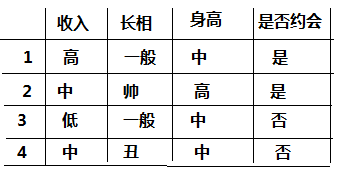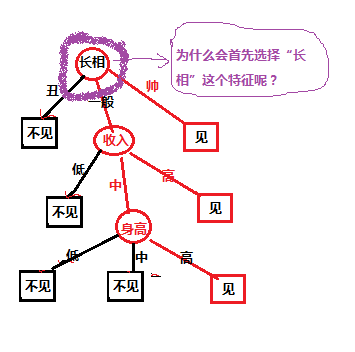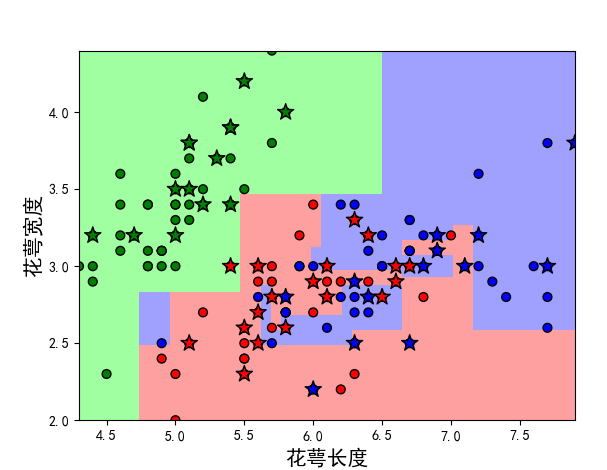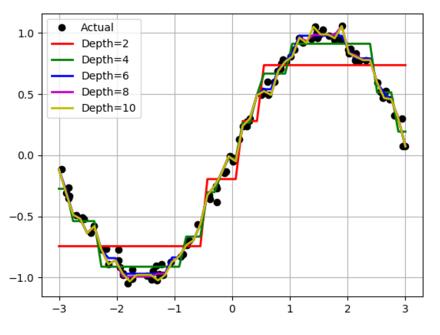本文申明:此文为学习记录过程,中间多处引用大师讲义和内容。
一、概念
决策树(decision tree)是一种简单但是广泛使用的分类器。通过训练数据构建决策树,可以高效的对未知的数据进行分类。决策数有两大优点:1)决策树模型可以读性好,具有描述性,有助于人工分析;2)效率高,决策树只需要一次构建,反复使用,每一次预测的最大计算次数不超过决策树的深度。
看了一遍概念后,我们先从一个简单的案例开始,如下图我们样本:

对于上面的样本数据,根据不同特征值我们最后是选择是否约会,我们先自定义的一个决策树,决策树如下图所示:

对于上图中的决策树,有个疑问,就是为什么第一个选择是“长相”这个特征,我选择“收入”特征作为第一分类的标准可以嘛?下面我们就对构建决策树选择特征的问题进行讨论;在考虑之前我们要先了解一下相关的数学知识:
信息熵:熵代表信息的不确定性,信息的不确定性越大,熵越大;比如“明天太阳从东方升起”这一句话代表的信息我们可以认为为0;因为太阳从东方升起是个特定的规律,我们可以把这个事件的信息熵约等于0;说白了,信息熵和事件发生的概率成反比:数学上把信息熵定义如下:h(x)=h(p1,p2,…,pn)=-∑p(xi)logp(xi)
互信息:指的是两个随机变量之间的关联程度,即给定一个随机变量后,另一个随机变量不确定性的削弱程度,因而互信息取值最小为0,意味着给定一个随机变量对确定一另一个随机变量没有关系,最大取值为随机变量的熵,意味着给定一个随机变量,能完全消除另一个随机变量的不确定性
现在我们就把信息熵运用到决策树特征选择上,对于选择哪个特征我们按照这个规则进行“哪个特征能使信息的确定性最大我们就选择哪个特征”;比如上图的案例中;
第一步:假设约会去或不去的的事件为y,其信息熵为h(y);
第二步:假设给定特征的条件下,其条件信息熵分别为h(y|长相),h(y|收入),h(y|身高)
第三步:分别计算信息增益(互信息):g(y,长相) = i(y,长相) = h(y)-h(y|长相) 、g(y,) = i(y,长相) = h(y)-h(y|长相)等
第四部:选择信息增益最大的特征作为分类特征;因为增益信息大的特征意味着给定这个特征,能很大的消除去约会还是不约会的不确定性;
第五步:迭代选择特征即可;
按以上就解决了决策树的分类特征选择问题,上面的这种方法就是id3方法,当然还是别的方法如 c4.5;等;
二、决策树的过拟合解决办法
若决策树的度过深的话会出现过拟合现象,对于决策树的过拟合有二个方案:
1.剪枝-先剪枝和后剪纸(可以在构建决策树的时候通过指定深度,每个叶子的样本数来达到剪枝的作用)
2.随机森林 --构建大量的决策树组成森林来防止过拟合;虽然单个树可能存在过拟合,但通过广度的增加就会消除过拟合现象
三、随机森林
随机森林是一个最近比较火的算法,它有很多的优点:
- 在数据集上表现良好
- 在当前的很多数据集上,相对其他算法有着很大的优势
- 它能够处理很高维度(feature很多)的数据,并且不用做特征选择
- 在训练完后,它能够给出哪些feature比较重要
- 训练速度快
- 在训练过程中,能够检测到feature间的互相影响
- 容易做成并行化方法
- 实现比较简单
随机森林顾名思义,是用随机的方式建立一个森林,森林里面有很多的决策树组成,随机森林的每一棵决策树之间是没有关联的。在得到森林之后,当有一个新的输入样本进入的时候,就让森林中的每一棵决策树分别进行一下判断,看看这个样本应该属于哪一类(对于分类算法),然后看看哪一类被选择最多,就预测这个样本为那一类。
上一段决策树代码:
|
1
2
3
4
5
6
7
8
9
10
11
12
13
14
15
16
17
18
19
20
21
22
23
24
25
26
27
28
29
30
31
32
33
34
35
36
37
38
39
40
41
42
43
44
45
46
47
48
49
50
51
52
53
54
55
56
57
58
59
60
61
62
63
64
65
66
67
68
69
70
71
72
73
74
75
76
|
# 花萼长度、花萼宽度,花瓣长度,花瓣宽度 iris_feature_e = 'sepal length', 'sepal width', 'petal length', 'petal width'iris_feature = u'花萼长度', u'花萼宽度', u'花瓣长度', u'花瓣宽度'iris_class = 'iris-setosa', 'iris-versicolor', 'iris-virginica' if __name__ == "__main__": mpl.rcparams['font.sans-serif'] = [u'simhei'] mpl.rcparams['axes.unicode_minus'] = false path = '..\\8.regression\\iris.data' # 数据文件路径 data = pd.read_csv(path, header=none) x = data[range(4)] y = pd.categorical(data[4]).codes # 为了可视化,仅使用前两列特征 x = x.iloc[:, :2] x_train, x_test, y_train, y_test = train_test_split(x, y, train_size=0.7, random_state=1) print y_test.shape # 决策树参数估计 # min_samples_split = 10:如果该结点包含的样本数目大于10,则(有可能)对其分支 # min_samples_leaf = 10:若将某结点分支后,得到的每个子结点样本数目都大于10,则完成分支;否则,不进行分支 model = decisiontreeclassifier(criterion='entropy') model.fit(x_train, y_train) y_test_hat = model.predict(x_test) # 测试数据 # 保存 # dot -tpng my.dot -o my.png # 1、输出 with open('iris.dot', 'w') as f: tree.export_graphviz(model, out_file=f) # 2、给定文件名 # tree.export_graphviz(model, out_file='iris1.dot') # 3、输出为pdf格式 dot_data = tree.export_graphviz(model, out_file=none, feature_names=iris_feature_e, class_names=iris_class, filled=true, rounded=true, special_characters=true) graph = pydotplus.graph_from_dot_data(dot_data) graph.write_pdf('iris.pdf') f = open('iris.png', 'wb') f.write(graph.create_png()) f.close() # 画图 n, m = 50, 50 # 横纵各采样多少个值 x1_min, x2_min = x.min() x1_max, x2_max = x.max() t1 = np.linspace(x1_min, x1_max, n) t2 = np.linspace(x2_min, x2_max, m) x1, x2 = np.meshgrid(t1, t2) # 生成网格采样点 x_show = np.stack((x1.flat, x2.flat), axis=1) # 测试点 print x_show.shape # # 无意义,只是为了凑另外两个维度 # # 打开该注释前,确保注释掉x = x[:, :2] # x3 = np.ones(x1.size) * np.average(x[:, 2]) # x4 = np.ones(x1.size) * np.average(x[:, 3]) # x_test = np.stack((x1.flat, x2.flat, x3, x4), axis=1) # 测试点 cm_light = mpl.colors.listedcolormap(['#a0ffa0', '#ffa0a0', '#a0a0ff']) cm_dark = mpl.colors.listedcolormap(['g', 'r', 'b']) y_show_hat = model.predict(x_show) # 预测值 print y_show_hat.shape print y_show_hat y_show_hat = y_show_hat.reshape(x1.shape) # 使之与输入的形状相同 print y_show_hat plt.figure(facecolor='w') plt.pcolormesh(x1, x2, y_show_hat, cmap=cm_light) # 预测值的显示 plt.scatter(x_test[0], x_test[1], c=y_test.ravel(), edgecolors='k', s=150, zorder=10, cmap=cm_dark, marker='*') # 测试数据 plt.scatter(x[0], x[1], c=y.ravel(), edgecolors='k', s=40, cmap=cm_dark) # 全部数据 plt.xlabel(iris_feature[0], fontsize=15) plt.ylabel(iris_feature[1], fontsize=15) plt.xlim(x1_min, x1_max) plt.ylim(x2_min, x2_max) plt.grid(true) plt.title(u'鸢尾花数据的决策树分类', fontsize=17) plt.show() |


以上就是决策树做分类,但决策树也可以用来做回归,不说直接上代码:
|
1
2
3
4
5
6
7
8
9
10
11
12
13
14
15
16
17
18
19
20
21
22
23
24
25
26
27
28
29
30
31
32
|
if __name__ == "__main__": n =100 x = np.random.rand(n) *6 -3 x.sort() y = np.sin(x) + np.random.randn(n) *0.05 x = x.reshape(-1,1) print x dt = decisiontreeregressor(criterion='mse',max_depth=9) dt.fit(x,y) x_test = np.linspace(-3,3,50).reshape(-1,1) y_hat = dt.predict(x_test) plt.plot(x,y,'r*',ms =5,label='actual') plt.plot(x_test,y_hat,'g-',linewidth=2,label='predict') plt.legend(loc ='upper left') plt.grid() plt.show() #比较决策树的深度影响 depth =[2,4,6,8,10] clr = 'rgbmy' dtr = decisiontreeregressor(criterion='mse') plt.plot(x,y,'ko',ms=6,label='actual') x_test = np.linspace(-3,3,50).reshape(-1,1) for d,c in zip(depth,clr): dtr.set_params(max_depth=d) dtr.fit(x,y) y_hat = dtr.predict(x_test) plt.plot(x_test,y_hat,'-',color=c,linewidth =2,label='depth=%d' % d) plt.legend(loc='upper left') plt.grid(b =true) plt.show() |

不同深度对回归的 影响如下图:

下面上个随机森林代码
|
1
2
3
4
5
6
7
8
9
10
11
12
13
14
15
16
17
18
19
20
21
22
23
24
25
26
27
28
29
30
31
32
33
34
35
36
37
38
39
40
|
mpl.rcparams['font.sans-serif'] = [u'simhei'] # 黑体 fangsong/kaiti mpl.rcparams['axes.unicode_minus'] = false path = 'iris.data' # 数据文件路径 data = pd.read_csv(path, header=none) x_prime = data[range(4)] y = pd.categorical(data[4]).codes feature_pairs = [[0, 1]] plt.figure(figsize=(10,9),facecolor='#ffffff') for i,pair in enumerate(feature_pairs): x = x_prime[pair] clf = randomforestclassifier(n_estimators=200,criterion='entropy',max_depth=3) clf.fit(x,y.ravel()) n, m =50,50 x1_min,x2_min = x.min() x1_max,x2_max = x.max() t1 = np.linspace(x1_min,x1_max, n) t2 = np.linspace(x2_min,x2_max, m) x1,x2 = np.meshgrid(t1,t2) x_test = np.stack((x1.flat,x2.flat),axis =1) y_hat = clf.predict(x) y = y.reshape(-1) c = np.count_nonzero(y_hat == y) print '特征:',iris_feature[pair[0]],'+',iris_feature[pair[1]] print '\t 预测正确数目:',c cm_light = mpl.colors.listedcolormap(['#a0ffa0', '#ffa0a0', '#a0a0ff']) cm_dark = mpl.colors.listedcolormap(['g', 'r', 'b']) y_hat = clf.predict(x_test) y_hat = y_hat.reshape(x1.shape) plt.pcolormesh(x1,x2,y_hat,cmap =cm_light) plt.scatter(x[pair[0]],x[pair[1]],c=y,edgecolors='k',cmap=cm_dark) plt.xlabel(iris_feature[pair[0]],fontsize=12) plt.ylabel(iris_feature[pair[1]], fontsize=14) plt.xlim(x1_min, x1_max) plt.ylim(x2_min, x2_max) plt.grid() plt.tight_layout(2.5) plt.subplots_adjust(top=0.92) plt.suptitle(u'随机森林对鸢尾花数据的两特征组合的分类结果', fontsize=18) plt.show() |
以上就是本文的全部内容,希望对大家的学习有所帮助,也希望大家多多支持服务器之家。
原文链接:https://blog.csdn.net/lisi1129/article/details/71055351










